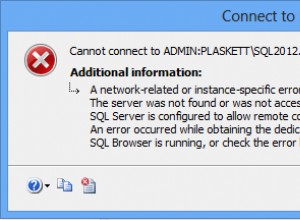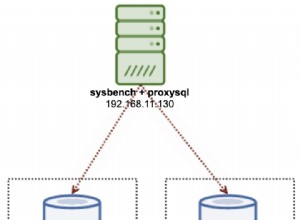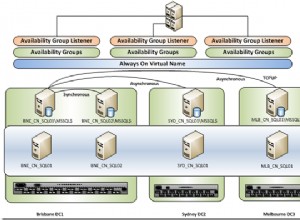Se sei interessato, ecco alcuni frammenti di codice per attivare il tipo di utente personalizzato Hibernate. Innanzitutto estendi il dialetto PostgreSQL per parlargli del tipo json, grazie a Craig Ringer per il puntatore JAVA_OBJECT:
import org.hibernate.dialect.PostgreSQL9Dialect;
import java.sql.Types;
/**
* Wrap default PostgreSQL9Dialect with 'json' type.
*
* @author timfulmer
*/
public class JsonPostgreSQLDialect extends PostgreSQL9Dialect {
public JsonPostgreSQLDialect() {
super();
this.registerColumnType(Types.JAVA_OBJECT, "json");
}
}
Quindi implementa org.hibernate.usertype.UserType. L'implementazione seguente associa i valori String al tipo di database json e viceversa. Ricorda che le stringhe sono immutabili in Java. Un'implementazione più complessa potrebbe essere utilizzata anche per mappare bean Java personalizzati su JSON archiviati nel database.
package foo;
import org.hibernate.HibernateException;
import org.hibernate.engine.spi.SessionImplementor;
import org.hibernate.usertype.UserType;
import java.io.Serializable;
import java.sql.PreparedStatement;
import java.sql.ResultSet;
import java.sql.SQLException;
import java.sql.Types;
/**
* @author timfulmer
*/
public class StringJsonUserType implements UserType {
/**
* Return the SQL type codes for the columns mapped by this type. The
* codes are defined on <tt>java.sql.Types</tt>.
*
* @return int[] the typecodes
* @see java.sql.Types
*/
@Override
public int[] sqlTypes() {
return new int[] { Types.JAVA_OBJECT};
}
/**
* The class returned by <tt>nullSafeGet()</tt>.
*
* @return Class
*/
@Override
public Class returnedClass() {
return String.class;
}
/**
* Compare two instances of the class mapped by this type for persistence "equality".
* Equality of the persistent state.
*
* @param x
* @param y
* @return boolean
*/
@Override
public boolean equals(Object x, Object y) throws HibernateException {
if( x== null){
return y== null;
}
return x.equals( y);
}
/**
* Get a hashcode for the instance, consistent with persistence "equality"
*/
@Override
public int hashCode(Object x) throws HibernateException {
return x.hashCode();
}
/**
* Retrieve an instance of the mapped class from a JDBC resultset. Implementors
* should handle possibility of null values.
*
* @param rs a JDBC result set
* @param names the column names
* @param session
* @param owner the containing entity @return Object
* @throws org.hibernate.HibernateException
*
* @throws java.sql.SQLException
*/
@Override
public Object nullSafeGet(ResultSet rs, String[] names, SessionImplementor session, Object owner) throws HibernateException, SQLException {
if(rs.getString(names[0]) == null){
return null;
}
return rs.getString(names[0]);
}
/**
* Write an instance of the mapped class to a prepared statement. Implementors
* should handle possibility of null values. A multi-column type should be written
* to parameters starting from <tt>index</tt>.
*
* @param st a JDBC prepared statement
* @param value the object to write
* @param index statement parameter index
* @param session
* @throws org.hibernate.HibernateException
*
* @throws java.sql.SQLException
*/
@Override
public void nullSafeSet(PreparedStatement st, Object value, int index, SessionImplementor session) throws HibernateException, SQLException {
if (value == null) {
st.setNull(index, Types.OTHER);
return;
}
st.setObject(index, value, Types.OTHER);
}
/**
* Return a deep copy of the persistent state, stopping at entities and at
* collections. It is not necessary to copy immutable objects, or null
* values, in which case it is safe to simply return the argument.
*
* @param value the object to be cloned, which may be null
* @return Object a copy
*/
@Override
public Object deepCopy(Object value) throws HibernateException {
return value;
}
/**
* Are objects of this type mutable?
*
* @return boolean
*/
@Override
public boolean isMutable() {
return true;
}
/**
* Transform the object into its cacheable representation. At the very least this
* method should perform a deep copy if the type is mutable. That may not be enough
* for some implementations, however; for example, associations must be cached as
* identifier values. (optional operation)
*
* @param value the object to be cached
* @return a cachable representation of the object
* @throws org.hibernate.HibernateException
*
*/
@Override
public Serializable disassemble(Object value) throws HibernateException {
return (String)this.deepCopy( value);
}
/**
* Reconstruct an object from the cacheable representation. At the very least this
* method should perform a deep copy if the type is mutable. (optional operation)
*
* @param cached the object to be cached
* @param owner the owner of the cached object
* @return a reconstructed object from the cachable representation
* @throws org.hibernate.HibernateException
*
*/
@Override
public Object assemble(Serializable cached, Object owner) throws HibernateException {
return this.deepCopy( cached);
}
/**
* During merge, replace the existing (target) value in the entity we are merging to
* with a new (original) value from the detached entity we are merging. For immutable
* objects, or null values, it is safe to simply return the first parameter. For
* mutable objects, it is safe to return a copy of the first parameter. For objects
* with component values, it might make sense to recursively replace component values.
*
* @param original the value from the detached entity being merged
* @param target the value in the managed entity
* @return the value to be merged
*/
@Override
public Object replace(Object original, Object target, Object owner) throws HibernateException {
return original;
}
}
Ora non resta che annotare le entità. Metti qualcosa del genere nella dichiarazione di classe dell'entità:
@TypeDefs( {@TypeDef( name= "StringJsonObject", typeClass = StringJsonUserType.class)})
Quindi annota la proprietà:
@Type(type = "StringJsonObject")
public String getBar() {
return bar;
}
Hibernate si occuperà di creare la colonna con il tipo json per te e gestirà la mappatura avanti e indietro. Inietta librerie aggiuntive nell'implementazione del tipo utente per una mappatura più avanzata.
Ecco un rapido esempio di progetto GitHub se qualcuno vuole giocarci:
https://github.com/timfulmer/hibernate-postgres-jsontype




